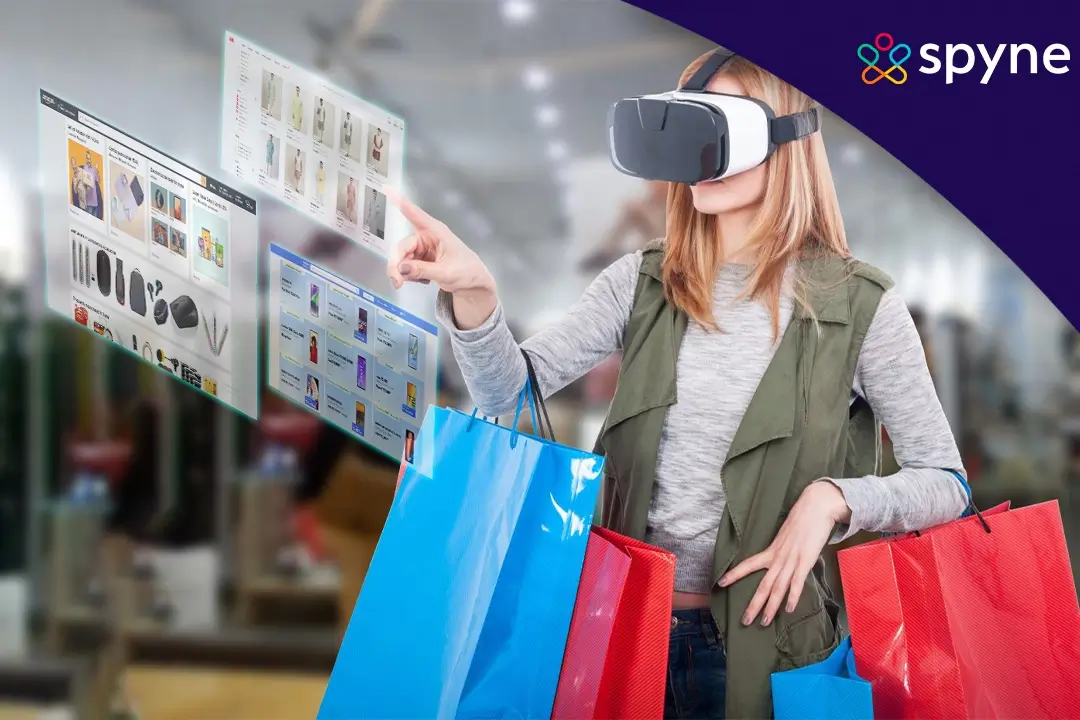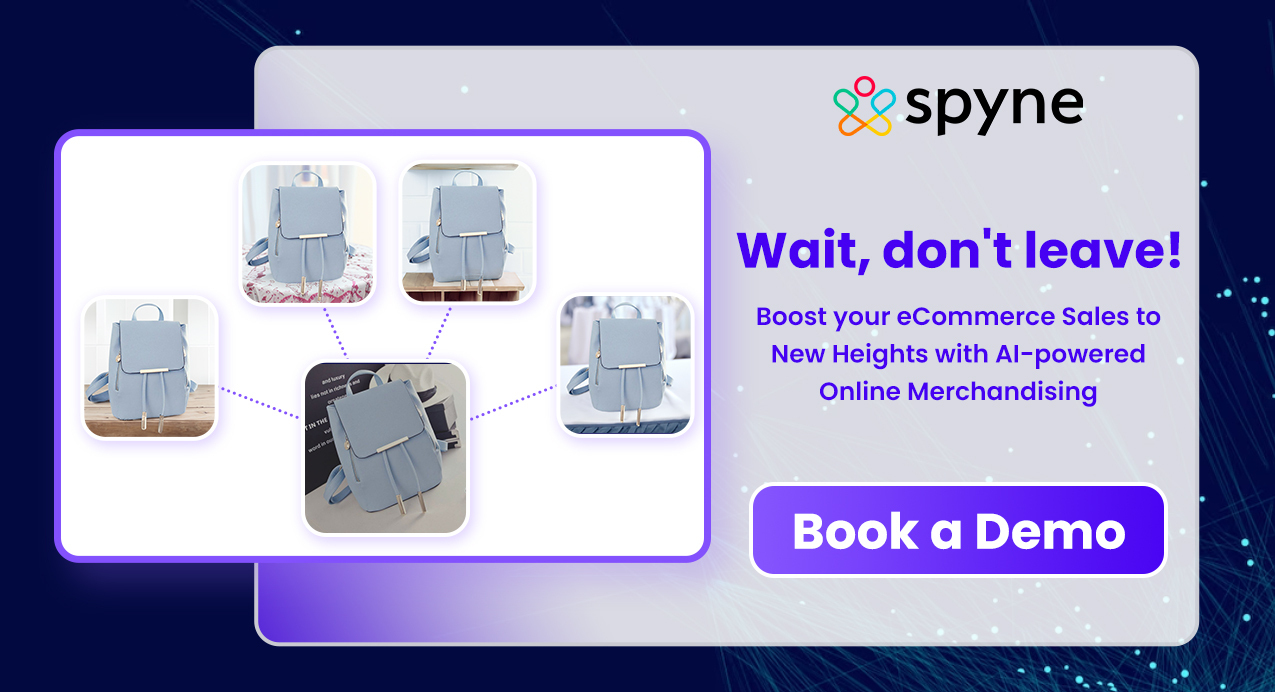Did you know that 75% of online shoppers rely on product images when making a purchase decision, and 92.6% consider visuals as the most influential factor in their buying choices? Furthermore, incorporating videos on product pages can increase conversion rates by a staggering 80%. It should make you understand the importance of visual commerce.
In today’s rapidly evolving digital landscape, businesses constantly seek innovative strategies to maximize sales and stay ahead of the competition.
It has emerged as a game-changing approach that leverages the power of visual content to captivate customers and drive conversion rates. Whether you’re a seasoned e-commerce entrepreneur or a budding online retailer, this guide will empower you to harness its power and revolutionize your sales strategy. Get ready to captivate your audience, inspire trust, and create unforgettable shopping experiences that drive remarkable growth.
What Is Visual Commerce?
Visual commerce refers to using visual content like images, videos, and interactive experiences to enhance the online shopping experience for customers. In order to draw customers and improve their purchasing experience, businesses adopt the visual commerce marketing strategy, which makes use of captivating visual content and augmented reality. By leveraging the power of optical elements, it aims to create visually attractive and interactive encounters that bridge the gap between traditional in-store experiences and the digital shopping realm.
The objective is to captivate consumers, facilitate the discovery of products, and ultimately boost sales. Hence, it encompasses a range of strategies that leverage visual content to facilitate the journey. It involves using visuals to showcase products, highlight features, and provide a better understanding of the product’s value proposition. By integrating visual elements seamlessly into the online shopping experience, brands can create a more immersive and memorable encounter for their customers.
Types of Visual Commerce
It encompasses several strategies and tactics businesses can employ to enhance the shopping experience for their customers.
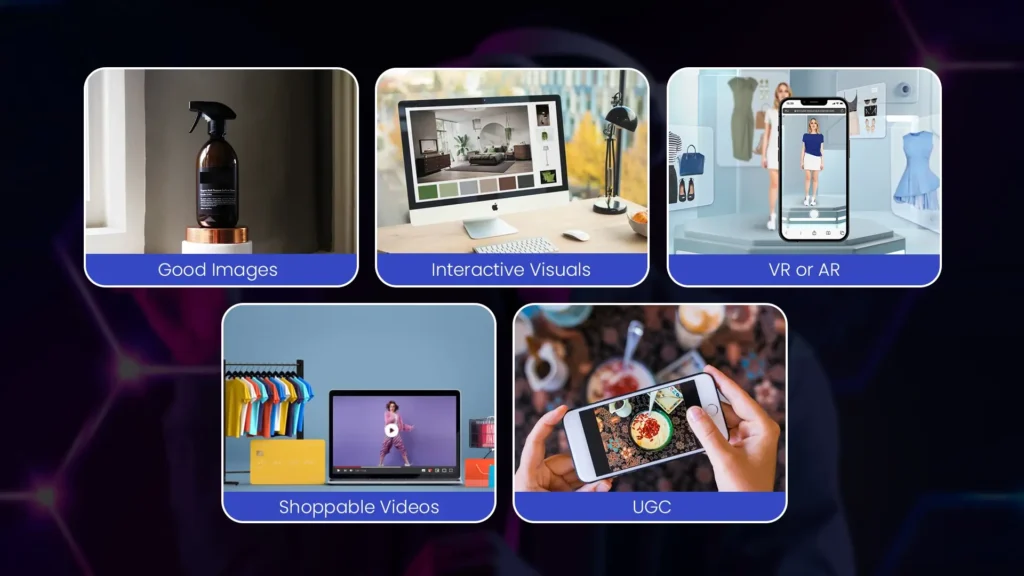
Some prominent commerce types of visual commerce include:
- High-Quality Product Imagery: Clear, high-resolution images showcase products from various angles and provide detailed views. Professional product photography or 3D-rendered photos can significantly enhance visual appeal.
- Interactive Product Visualization: This involves providing interactive 360-degree product images or videos that allow customers to rotate and explore products from different angles. So, this interactivity provides a more immersive and engaging experience.
- Virtual Try-On and Augmented Reality (AR): Virtual try-on features enable customers to try on products using their devices virtually. So, AR technology overlays virtual content in the real world, allowing customers to visualize how products look or fit in their environment.
- Shoppable Videos: Videos that include clickable links or embedded product information, enabling customers to purchase products while watching the content directly. This seamless integration of shopping within videos can boost conversions and enhance convenience.
- User-Generated Content (UGC): Encouraging customers to share their photos and videos featuring purchased products. UGC adds authenticity to the shopping experience and can influence potential buyers.
Why Visual Commerce Is Important
In the digital era, visual commerce is crucial as it effectively grabs attention and engages customers more than simple text-based approaches. By incorporating captivating visual content like images, videos, and interactive experiences, brands can improve customers’ understanding of their products, boost conversion rates, and establish a prominent brand identity. It also facilitates social media sharing and user-generated content, setting brands apart in a highly competitive market and reaching customers across diverse platforms.
Why are Brands using Visual Commerce?
Brands increasingly embrace visual commerce due to its remarkable ability to captivate consumers and foster engagement. Visual content possesses a more significant influence on individuals compared to text alone. Using visually compelling elements, brands can craft memorable, immersive experiences that deeply resonate with customers. This, in turn, results in heightened brand awareness, strengthened customer loyalty, and, ultimately, amplified sales.
Why Does it Matter for Online Retail?
In the highly competitive world of online retail, standing out from the crowd is crucial. Visual commerce lets online retailers differentiate themselves by offering a more engaging and interactive shopping experience. It helps overcome the limitations of the digital realm, where customers cannot physically touch or try on products before purchasing. By leveraging visual content, online retailers can bridge this gap and provide customers with a more immersive and satisfying shopping experience.
Benefits of Visual Commerce for Online Retailers
Online retailers can take advantage of the numerous benefits of visual commerce.
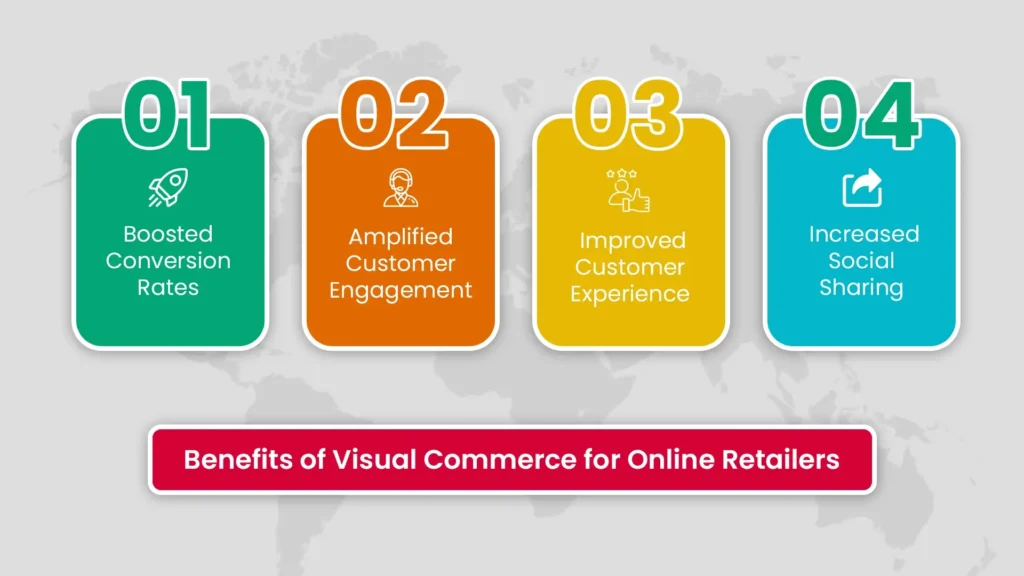
Here are six of the significant benefits:
- Amplified Customer Engagement: Visual content captivates customers’ interest and entices them to spend more time engaging with products. Hence, this heightened level of engagement nurtures a stronger affinity towards the brand and increases the probability of customers purchasing.
- Increased Social Sharing: Compelling visual content is more likely to be shared on social media platforms. When customers share their positive experiences or user-generated content featuring products, it amplifies brand visibility and serves as social proof, influencing others to consider purchasing.
- Improved customer experience: Delivering an online shopping experience that replicates the in-store experience is made simpler by visual commerce. Customers who prefer to shop from home can interact with in-store merchandise using augmented reality capabilities.
- Increased sales: Customers are more likely to make a purchase if they can more easily picture the advantages of a good or service in their lives. Visual commerce, according to Annex Cloud, can, on average, boost conversion rates by 5% to 7%.
- Brand differentiation: Strong execution is needed for visual commerce. But when done properly, it can set apart your brand from the plethora of competitors and make it distinctive and unforgettable.
- Cost reduction: Investing in visual commerce tools can help eCommerce businesses reduce photography expenditures. The Square Photo Studio app, for instance, uses artificial intelligence to extract backdrops and add translucent ones with the click of a button. Normally, a professional photographer would be needed for each of these jobs.
How Brands Use Visual Commerce to Drive E-commerce Sales
Brands leverage it to boost e-commerce sales by employing various strategies. They invest in high-quality product imagery to showcase products appealingly. Interactive product displays and videos demonstrate product features and usage. User-generated content adds social proof and authenticity. Through visual commerce, brands create engaging and immersive shopping experiences, capturing customer attention and driving conversions.
So, it helps them communicate their brand story, build trust, and establish a competitive edge in online retail.
Creating Stunning Product Galleries: By curating visually appealing product galleries, brands can showcase their offerings in an aesthetically pleasing manner, enticing customers to explore further. Implementing Interactive
Product Visualisations: Brands leverage interactive visualizations to enable customers to customize products, visualize different options, and make more informed purchasing decisions.
Integrating User-Generated Content: Brands encourage customers to share their experiences and visuals, leveraging user-generated content to enhance social proof and credibility.
Explanation of How Brands Use Visual Commerce
There are many different ways that brands use visuals in their business.

Here are the different ways visuals are used in commerce:
- Captivating Product Imagery: Brands invest in high-quality product photography and 3D-rendered images to showcase their products in the best light. Therefore, it focuses on presenting products from multiple angles, highlighting key features, and providing context to enhance the visual appeal.
- Interactive Product Visualisation: Brands utilize 360-degree product images or videos to enable customers to explore products more engaging and immersive. This interactivity enhances customer engagement and allows a better understanding of the product.
- Virtual Try-On and AR Experiences: Brands leverage virtual try-on features and AR technology to enable customers to visualize products in real-world settings or try them on virtually. This helps customers make more confident purchasing decisions, particularly in the fashion, beauty, and home décor industries. Fashion photography, in particular, can significantly help VR/AR experience.
- Shoppable Videos: Brands create videos that seamlessly integrate product information and purchase links, allowing customers to purchase directly while watching the content. This visual commerce strategy leverages the power of video as a medium to drive sales.
- User-Generated Content (UGC): Brands encourage customers to share their experiences through photos and videos featuring products. By showcasing authentic user-generated content, brands create social proof and foster community around their products.
Examples of Visual Commerce in Action: Transforming the Shopping Experience
It is filled with many significant and distinct examples.
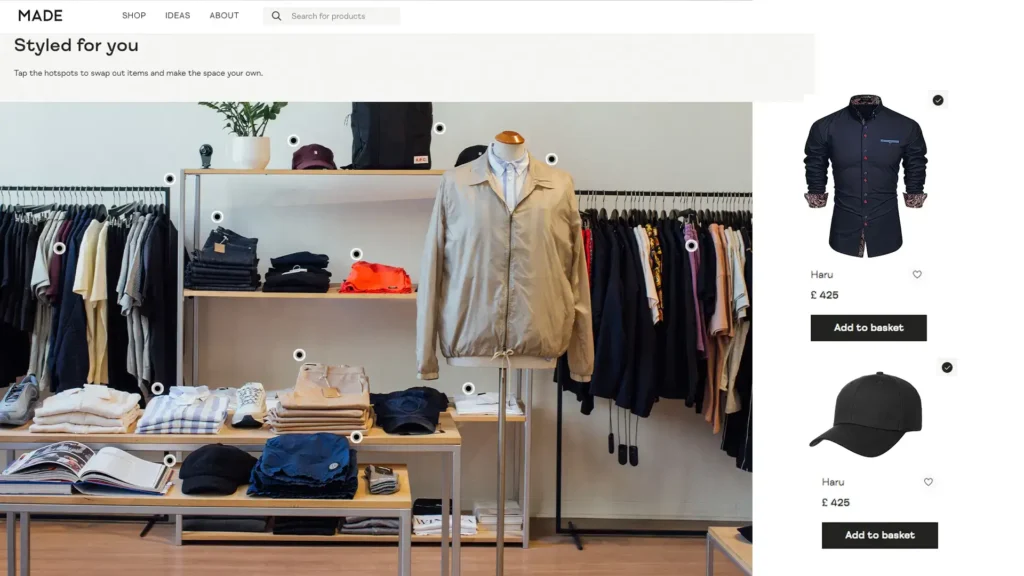
Here are three examples of visual commerce:
- Sephora: Sephora’s Virtual Artist feature allows customers to try makeup virtually using their device’s camera. This AR experience helps customers visualize how different products would look on them, leading to informed purchasing decisions.
- IKEA: IKEA’s augmented reality app lets customers virtually place furniture and decor items in their spaces. So, it lets customers see how products fit and look in their homes, facilitating purchase decisions.
- ASOS: ASOS utilizes interactive product visualization by providing 360-degree views of clothing items. Customers can rotate the images and zoom in to examine the products closely, providing a more detailed understanding.
Best Visual Commerce Platforms and Tools
Most of these platforms and tools provide various extensions, integrations, themes, and apps for e-commerce visual merchandising and product showcasing. Some popular visual commerce tools and platforms include:
- Shopify is a widely used e-commerce platform offering various tools and features for creating online stores. E-commerce photography will help you take your website to new heights.
- Magento: Magento is a powerful open-source e-commerce platform that provides flexibility and customization options.
- WooCommerce: WooCommerce is a popular e-commerce plugin for WordPress. It provides a user-friendly interface and offers numerous themes and extensions to create visually appealing online stores.
- BigCommerce: BigCommerce is a comprehensive e-commerce platform that allows businesses to build visually stunning online stores. It offers advanced features such as product visualization, personalization, and customer segmentation.
- Salesforce Commerce Cloud: Salesforce Commerce Cloud is an enterprise-level platform with robust capabilities.
- Adobe Commerce: Formerly known as Magento Commerce, Adobe Commerce is a feature-rich e-commerce platform that offers extensive visual merchandising options.
- Visualsoft: Visualsoft is an e-commerce platform focusing on visuals and user experience. It offers responsive design templates, product visualization tools, and personalized shopping experiences.
- Olapic: Olapic is a visual marketing and commerce platform that helps businesses collect, curate, and display user-generated content. It enables brands to create visually engaging experiences and leverage user-generated imagery.
- Bazaarvoice: Bazaarvoice is a platform that provides solutions for visuals, customer ratings, and reviews. So, it allows businesses to showcase user-generated content, ratings, and reviews to enhance product visibility and consumer trust.
- Yotpo: is a visual marketing and user-generated content platform that helps businesses collect and display customer reviews, photos, and videos. It enables brands to leverage user-generated content to drive commerce.
What to Look for When Choosing a Visual Commerce Platform
Choosing the right platforms and tools is essential when implementing its strategies. Here are some factors to consider when selecting a visual commerce platform:
- Ease of use and integration with existing systems.
- Customizability and flexibility to align with brand aesthetics.
- Compatibility with various devices and screen sizes.
- Support different types of visual content, such as images, videos, and AR experiences.
- Robust analytics and reporting capabilities.
- Support for visual search and interactive features.
- Reputation, reliability, and security of the platform provider.
Visual Commerce – Best Tips for Your Business
Tips for your business can help you implement and use visuals more effectively.
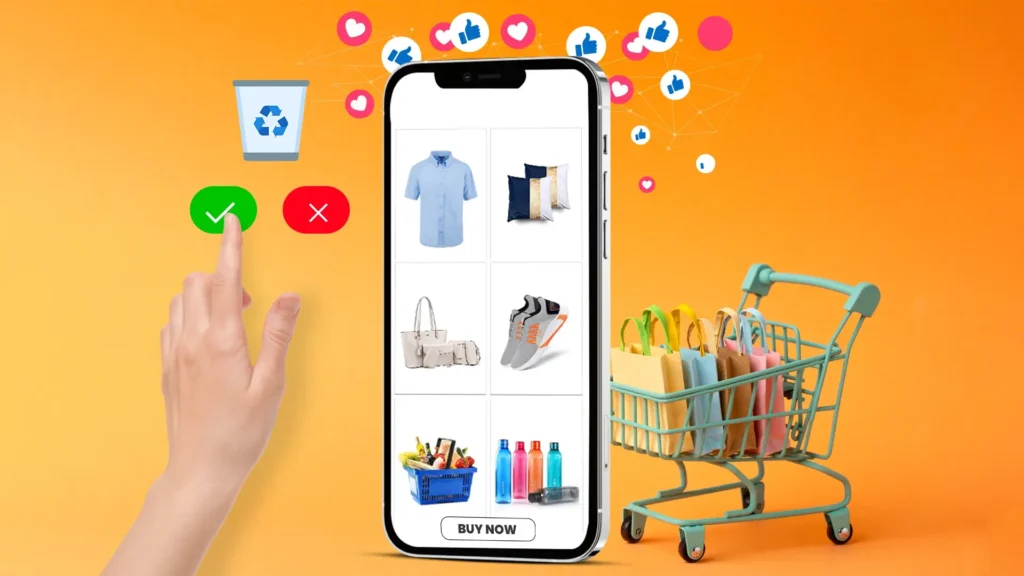
Here are some tips for your business.
- Prioritise High-Quality Visual Content: To effectively capture customers’ attention and showcase your products, invest in high-resolution images, professional or well-executed DIY product photography, and visually appealing videos.
- Optimise for Mobile Devices: Given the increasing use of smartphones for online shopping, ensure that your visual commerce experiences are optimized for mobile devices. So, it includes making them user-friendly, responsive, and compatible with different screen sizes.
- Embrace User-Generated Content: Encourage customers to share their experiences by incorporating user-generated content on your website and social media platforms. So, this adds authenticity to your brand and serves as social proof, influencing potential customers’ purchase decisions.
- Personalize the Experience: Leverage customer data and preferences to deliver personalized visual experiences. So, it will tailor product recommendations and visual content based on individual customer behavior and preferences.
- Continuously Test and Optimise: Monitor the performance of your strategies and make data-driven optimizations to improve conversions and customer engagement.
- Optimise Images and Videos: Ensure your visual assets are optimized for fast loading times and display correctly across various devices.
- Maintain Consistency: Establish a consistent visual style and branding across all your visual content to reinforce brand identity and recognition.
- Leverage User-Generated Content: Encourage customers to share their experiences and visuals, amplifying your reach and building trust.
- Test and Iterate: Continuously test different visual strategies and monitor their impact on critical metrics. So, use the insights gained to refine and improve your visual commerce approach
What are the Four Tools that Comprise a Visual Commerce Platform?
The four tools that make up a Visual Commerce Platform, typically include:
1) Visual Engine: A visual engine is a core component of a Visual Commerce Platform that enables a variety of visual experiences, such as 3D product views, virtual commerce photography, and augmented reality (AR) interactions. It helps showcase products in an engaging and interactive way, enhancing the overall shopping experience.
2) Product Configurator: A product configurator is a tool that allows customers to customize and personalize products according to their preferences. It provides options for selecting colors, materials, sizes, and other product features, giving customers a sense of ownership and helping them visualize the final product.
3) Omnichannel Distribution: Omnichannel distribution refers to the capability of a Visual Commerce Platform to seamlessly deliver visual content and product information across various channels and touchpoints. This includes websites, mobile apps, social media, in-store displays, and more, ensuring a consistent and cohesive brand experience.
4) Composable Platform: A composable platform is a flexible and modular system that allows businesses to customize and integrate different components and functionalities of the Visual Commerce Platform to meet their specific needs. It enables scalability and adaptability, making it easier to tailor the platform to evolving business requirements.
These tools collectively enhance the way businesses showcase and sell their products, creating a more engaging and personalized shopping experience for customers.
Conclusion
Visual commerce has revolutionized online retail by leveraging captivating visuals to engage customers, improve their shopping experience, and boost e-commerce sales. It offers brands a powerful strategy to create immersive shopping experiences through high-quality visual content, interactive features, augmented reality (AR) technology, and user-generated content. So, by carefully selecting visual commerce platforms and tools that align with your brand’s needs and considering factors like user-friendliness, flexibility, and compatibility, you can tap into its limitless potential.
Implementing the recommended best practices and tips outlined in this guide will enable you to unlock its full power, propelling your e-commerce business to new heights of success.

